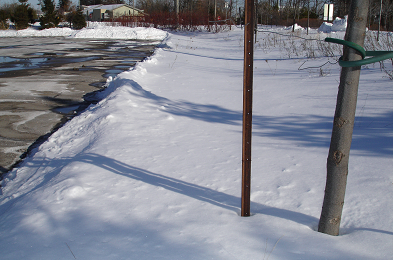Winter
Salt and Snow[edit]
Sodium and chloride ions in de-icing salts applied to asphalt areas travel easily with the runoff water. De-icing salt can increase the mobility of some heavy metals in soil (e.g. lead, copper or cadmium). This may increase the downstream concentration of these metals (Amrhein et al., 1992; Bauske and Goetz, 1993).
Very few studies have sampled groundwater below infiltration facilities or roadside ditches receiving de-icing salt laden runoff have found concentrations of heavy metals that exceed drinking water standards (e.g., Howard and Beck, 1993; Granato et al., 1995).
To minimize risk of groundwater or soil contamination, the following management approaches are recommended (Pitt et al., 1999; TRCA, 2009b):
- Stormwater infiltration practices should not receive runoff from the following areas:
- Where large amounts of de-icing salts are applied (e.g., busy highways), or
- Pollution hot spots (e.g. vehicle fuelling, servicing or demolition areas, outdoor storage or handling areas for hazardous materials, and some heavy industry sites);
- Prioritize infiltration of runoff from source areas that are comparatively less contaminated such as roofs, low traffic roads and parking areas; and
- Apply pretreatment practices before infiltration of road or parking area runoff.
Planning[edit]
Recommended planning strategies in designing sites for reduced salt usage:
Effective Grading Areas for vehicular and pedestrian traffic should be graded between 2 - 4% to reduce the chances of depressions forming. Sub bases should be well compacted for the same reason. Preventing ponding and ice formation reduces the salting requirements for those surfaces. In winter months efficient salt application should be made along the top of slopes. Melting snow will carry the salt solution down-gradient.
Snow Piles Storage locations for snow piles should be in sunny areas with low traffic. Consider grading the storage location to distribute the melt-water as sheet flow over a grass filter strip into an adjacent BMP, such as a bioretention cell or infiltration trench. In some cases, with careful vegetation selection and adequate drainage, the BMP itself can serve as a snow storage location. Snow storage areas should be clearly marked for seasonal maintenance staff.
Sidewalk Design and Pedestrian Flow Sidewalks which receive infrequent use could be closed for the winter season. Maintained sidewalks should be ≥ 1.5 m wide to accommodate plowing and minimize the salting required. Using textured pavers can improve grip for pedestrians, again reducing the salt required. In busy areas around building entrances, covered walkways and heated mats also reduce salt requirements.
Trees Specifying deciduous trees will maximize winter sunlight penetration. This will naturally enhance the melting of frozen surfaces, limiting the need to winter maintenance.
Vegetation
Vegetation varies in its reaction to salt-affected soils.
- Salt in soil water generally makes it more difficult for roots to take up water. This phenomenon mimics drought conditions for the plant.
- If passing traffic sprays salty water onto plants it can reduce cold hardiness in buds and new twigs. These then become more susceptible to freezing, mortality or deformation.
- In high enough concentrations sodium and chloride can also be directly toxic to plants. In some species the ions are absorbed by t he plant and build up in the leaves causing them to die
Other Freezing Related Concerns[edit]
Rainwater harvesting Freezing temperatures can cause problems with pipes and cisterns exposed above the frost penetration line[1]. This maybe a significant issue for rainwater harvesting systems, including residential rain barrels.
Green Roofs Somewhat counter-intuitively, the survival of green roof planting is greater in winters with long deep sub-zero temperatures. Being shallow and very exposed to warming sunlight, green roofs thaw rapidly. Frequent freeze-thaw cycles in the early and late winter is associated higher loss of vegetation on green roofs.
IMAGES?
